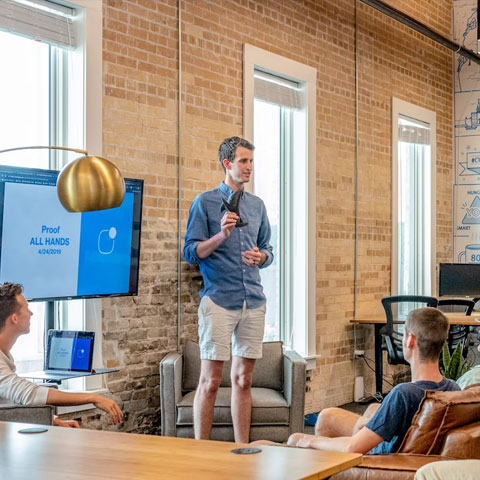Maximising Human Interaction is Central to the FMCG Customer Experience


FMCG brands are focusing on ways to connect physical retail spaces with the digital world. But they should never lose sight of consumer demand for human engagement.
Consumer packaged goods businesses are among those that have the highest frequency of interaction with their customers through direct purchases. But, as CX experts in those organisations know only too well, it can be difficult to fully control the brand experience.
Yet this scenario is shifting. Not only have FMCG brands established their own Direct-to-Consumer (DTC) models through branded stores and websites, but retailers are also offering more interesting ways of connecting with consumers throughout the store and at point of sale.
Emerging tech is playing a key role here, shaping the potential for vast tracts of customer data to be mined by retailers to offer retail media solutions to FMCG businesses. Meanwhile, the brands themselves are establishing direct connections with their consumers through data collection and subscription services.
But within this ecosystem of tech investment, it's important for FMCG brands not to lose sight of the need for human interaction. This is one of the key themes highlighted in the new report from Merkle - CX Imperatives: From Customer Engagement to Customer Empowerment.
Based on the findings of a consumer study that reveals six critical imperatives for CX professionals, the report identifies meeting the customer's need for real live human interaction as a key imperative.
The research also shows that consumer demand for a balance between digital and human interaction is more noticeably one-sided in FMCG than other categories. There's a pronounced preference for human contact throughout the customer journey, especially at the purchase and post-purchase support stages.
People-centric retail media
Underpinned by loyalty data, retail media is providing new ways for FMCG brands to grow this human connection. For example, there are now opportunities to target and influence people at point of sale based on their personalised preferences.
Tesco Media is working on offering FMCG brands new ways to target customers while they are shopping. In the UK it recently launched dynamic Scan As You Shop ad placements onto in-store handsets, as well as over 1,000 in-store digital screens and more than 500 onsite digital performance ads.
FMCG brands are also taking more direct control of the instore customer experience with the basic addition of QR codes on products to provide a simple feedback loop and data collection opportunity.
QR codes can play a more fundamental role in the customer experience. Unilever brand Persil, for example, provided enhanced QR codes to improve accessibility, partnering with the charity RNIB to offer the UK's 2 million blind and partially sighted people access to product information and a more inclusive shopping experience.
Once accessed via smartphone, the code provided product, usage, safety and recycling information in a structured way that was designed with blind and partially sighted users in mind. It also gathered feedback to improve both the technology and product.
In a nutshell, these instore innovations work because consumers are looking for digital payments backed by in-person support. It’s worth noting here, however, that physical and digital channels are increasingly intertwined, and consumers typically don’t perceive a hard distinction between the two when the digital experience is delivered with human need at its heart.
This is vital in categories such as household and personal care, where individual requirements for skincare and detergents can be varied due to different hair and skin types.
DTC models tend to be sophisticated in delivering this customisation, and are also used to test new products, pricing models and promotions, and in providing personally-tailored products and packaging.
For example, in reaction to DTC competition from brands including Harry's and Dollar Shave Club, Procter & Gamble launched Gillette Club, to trial new products and offer tailored promotions and subscriptions. But it's also a space for consumer advice and providing content at the early research and consideration stages of the journey.
Brands are also bringing the customisation model instore. L'Oréal beauty brand Lancôme launched its Skin Screen service to offer personalised product advice and recommendations. It enables beauty professionals to conduct a skin analysis test supported by light technology and AI-powered algorithms to measure key skin parameters based on a library of 6,000 skin “diagnosis” images. Lancôme is then able to provide skincare recommendations based on the results.
Supporting the consumer
Lancôme's initiative fits with the finding from our research that shows rising consumer demand for access to more information through research tools to support their purchase decision. More than a third (34%) identify this support as a preferred attribute of their future experiences with brands (rising to 41% among 18-34s).
FMCG brands should also consider the use of emerging technologies such as AI to drive chatbots and live chat functionalities that enable brands to create a two-way communication stream with the customer.
For instance, to aggregate all the comments shared on brand websites and distributor platforms, L'Oréal developed an AI-powered semantic and quantitative analysis platform for consumer reviews. The system, dubbed Consumer Loop, is a digital dashboard updated in real time by the marketing, research and innovation teams.
In this example technology is clearly applied to enhance human interactions and improve both the brand and product experience. Digital technology and human representatives are working in harmony to deliver experiences that make the customer feel recognised and valued. This is the key to success in delivering an optimised customer experience in the FMCG world.
Uncover further compelling FMCG and CPG experience insights by downloading our report, 2024 CX Imperatives: From Customer Engagement to Customer Empowerment. Or if you’d like to discuss your brand’s needs in this space, please do get in touch.
Want more like this?
Want more like this?
Insight delivered to your inbox
Keep up to date with our free email. Hand picked whitepapers and posts from our blog, as well as exclusive videos and webinar invitations keep our Users one step ahead.
By clicking 'SIGN UP', you agree to our Terms of Use and Privacy Policy


By clicking 'SIGN UP', you agree to our Terms of Use and Privacy Policy
Other content you may be interested in
Categories

Want more like this?


Want more like this?
Insight delivered to your inbox
Keep up to date with our free email. Hand picked whitepapers and posts from our blog, as well as exclusive videos and webinar invitations keep our Users one step ahead.
By clicking 'SIGN UP', you agree to our Terms of Use and Privacy Policy









